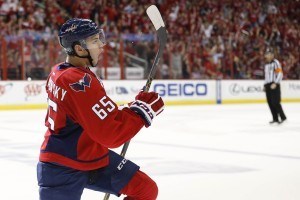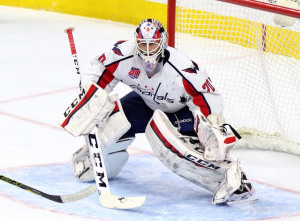The Washington Capitals had enough success during the 2014-15 season, especially after December 1 and into the playoffs, to think that with the right minor adjustments they could be a legitimate Stanley Cup contender in the coming years. But they also built upon their past history of agonizing playoff defeats, so of course there always is doubt among the team’s faithful.
With the NHL Draft at hand and the annual July 1 free agent frenzy peering around the corner, the big question for second-year Caps General Manager Brian MacLellan is pretty obvious: What next?
“Overall I think we’ve made a lot of progress,” MacLellan told reporters immediately following the team’s dismissal from the playoffs. “From where we started at the beginning of the year to where we’ve ended up I think we’ve made huge strides as an organization and I think we learned from what happened at the end and will address things and try to make it better and get over that hurdle next year.”
Sounds reasonable. But how do you make it over that hurdle? Right now the team’s direction this offseason is not totally clear, but we should begin to get some idea of the organization’s plans in the next two or three weeks.
Draft or Trade?
Washington has been mentioned as a possible destination for embattled winger Patrick Sharp of the Chicago Blackhawks. Apparently the Caps and Hawks did the dance right around trade deadline time, but the price must have been too high at the time. It seems as though that is likely the case since the word on the street right now is that Chicago wants a first-round pick, a top-level prospect and a potential top-six forward currently on an entry level contract in return.
Even though MacLellan has been adamant that the team needs to find a top-six wing, and he feels what they are looking for is not available in free agency, that asking price seems too steep considering that Sharp was only healthy enough to play in 68 games and saw his point production cut nearly in half after a career year in 2013-14 (78 points, more than 30 goals and an Olympic gold medal).
“It’s on the shopping list,” MacLellan said, referring to a top-six wing. “I think it would be a priority for us if we could find a guy who could play there. I don’t know that the UFA market is going to provide that for us. We’ll see what happens in the trade market here coming up. Otherwise we’re going to have to develop a guy. We’re going to have to look at a (Andre) Burakovsky. We’re going to have to find a guy, but it is a priority. “

Clearly Burakovsky is the long-term answer. After a quick start last year, including a goal in his first NHL game, Burakovsky was brought along slowly, bouncing back and forth between DC and Hershey, before becoming a key contributor in the postseason. He has the skill set to be a first- or second-line player for sure – good speed, great vision, soft hands and a quick shot release – but is he the guy to live and die with on the first line with two world-class players at this point in his career? There are sure to be more growing pains ahead for the talented youngster.
And if you look at the second line, would a trio comprised of Burakovsky along with the swift and skilled Evgeny Kuznetsov and Marcus Johansson provide the physical presence necessary to be successful at the NHL level? Perhaps the tremendous amount of speed and skill those three possess could allow them to succeed, but you are banking on three players under the age of 25 playing a huge offensive role together.
“I’d like ideally to get an established forward in our lineup somehow to complement the young guys and Ovie and Backstrom,” MacLellan said.
That brings us back to Sharp. Is he declining or was this just one of those bad-luck years? He started off injured and then never seemed to fully climb back into the fold for a deep and talented Chicago team. There were spurts of greatness in December and January and then rumors of locker room drama and off-ice personal issues. But he is one year removed from a career-best season, has scored 30 or more goals in four of the last six campaigns and has won multiple Stanley Cups.
Sharp will be 34 in December, so he’s hardly over the hill, but he’s also at that age where a downward trend in production is entirely possible. Oh, and he’s due $12 million over the next two seasons. Could Sharp be the right fit? Yes, of course, but not at the current asking price. But as we all know this is a negotiation, and the Blackhawks are well aware that they are not going to get their initial ask. Will they take two of the three components they supposedly are seeking? My bet is yes, but that still is a tough sell – although certainly more palatable.
The Pick
So if Sharp is off the table at the moment, what do the Caps do with the 22nd draft pick? Trade it for one of the other potentially available top-six guy such as T.J. Oshie, Kyle Okposo and Radim Vrbata or keep the pick and stock the farm system? The Capitals have only traded their first-round pick once in the past 13 years (for Troy Brouwer five years ago) and have had a lot of success over the years drafting in the 20s, selecting players such as Burakovsky (26), Kuznetsov (24), Johansson (24) and Carlson (27).
Nine of the 18 skaters who ended the season on Washington’s roster were homegrown draft picks, so the odds of the team holding onto the pick and waiting until free agency begins or even as late as the trade deadline seem pretty good.
“We’re going to have to find a guy (to play in the top six),” MacLellan said. “It’s a priority. You don’t like to see revolving guys go through that spot all year. You’d like to see some stability where a guy is there the whole year or most of the year. You’re always changing lines, but we’d like to find a guy who can play there.”
How Do the Pieces Fit?
According to estimates the Caps should have between $21 and $23 million available under the new salary cap, and as of right now they have 13 skaters and two goalies signed.
Unrestricted free agent Curtis Glencross appears to be on the way out. Defenseman Tim Gleason, like Glencross acquired at the trade deadline, is a longshot to return but could be a good veteran addition late in the game once all of the priorities are taken care of. UFAs and longtime Caps Eric Fehr, Jay Beagle and Joel Ward are the others who could test the market if not signed by July 1. Defenseman Mike Green, who played in a No. 5/6 role last season would only be a fit if open to a sizable salary reduction (UPDATE 2:23pm June 25 – Fehr and Green to test market). He will probably command twice what Washington would offer on the open market, but says his heart remains in DC.

On the RFA side, Braden Holtby clearly is priority number one after his career year and outstanding postseason, with Johansson and Kuznetsov, another strong playoff performer, right behind him. Getting them signed appears to be the first order of business and then the dominoes should start to fall into place.
“With all the restricted guys we’re going to be working on them simultaneously. It’s not going to be just Braden,” MacLellan said. “We like Beags. We want to get Beags on a good number and as a fourth line player. We want to bring Marcus Johansson back. He’s 25 years old and still developing and we think we can get more out of him going forward and Kuznetsov has been a big part of our success at the end of the year.”
So, in fitting the puzzle together let’s assume that those RFAs and Beagle are signed, probably for somewhere in the vicinity of $12 million. At that point your lineup looks something like this:
First Line: Ovechkin-Backstrom-Burakovsky or ?
Second Line: Johansson-Kuznetsov-Burakovsky or?
Bottom Six Mix: Chimera, Brouwer, Laich, Beagle, Latta, Wilson, Barber, O’Brien, Vrana, Galiev (Vrana and Galiev are probably more suited to top six consideration given their style of play)
Defense: Carlson, Alzner, Niskanen, Orpik, Orlov, Schmidt
Goal: Holtby, Grubauer, Peters
MacLellan said that it is time to move hard-hitting Tom Wilson into the top-nine mix and that he ultimately thinks the youngster can be a top-six forward. He also was pretty clear that he sees Beagle as a fourth-liner. So, if we pencil those two into the lineup on the third and fourth lines, respectively, you have a least one longtime veteran – Brooks Laich, Jason Chimera or Brouwer – staring at a potential fourth-line role.
That brings us to Ward. Fan favorite. Clutch postseason performer. Great in the locker room. But he’s 34 and wants a three-year deal. Someone on the market is likely to overpay for his services or at least take a risk and ink him through his 37th birthday. He’s the kind of guy you need, but in this time of salary caps and fiscal prudence it just may not work – unless you exhaust all top-six forward trade options and feel like he’s as good a fit as anyone you can get as a first- or second-line wing. That is possible, but still would most likely mean Ward would have to accept two years instead of three.
“Joel’s got less mileage for a guy in his 30s because he started late,” MacLellan said. “I think there’s a little bit to that, but as you get older there’s a little bit of deterioration no matter how much mileage you have on you. So I think term is going to be an issue there going forward. If we can work in a good number and we feel Joel can continue playing at the level he’s been playing we will work it out.”
A Look into the Crystal Ball
How will the Capitals’ offseason pan out? There are so many moving parts that it’s hard to predict, but I’ll take a stab at it.
Clearly Washington will sign RFA’s Holtby, Johansson, and Kuznetsov and appear likely to ink UFA Beagle, but now it looks like Fehr will most likely walk. The Capitals will keep their draft pick and make that selection later this week. Joel Ward will get a three-year contract offer on the open market and not be back. A veteran depth defenseman, possibly Gleason, will signed – although it seems as though a right-handed defenseman would make more sense.
Looking at the salary cap, if Washington has, say, $22 million available and can get the RFA’s plus Beagle and a veteran defenseman for $13 million or less (seems doable), a trade for a Sharp or similar player could be pulled off.
Initially my bet was that the Capitals would enter the season with Burakovsky penciled into a top-six role, possibly on the first line, without making the big trade. His analytics were off the charts in the three or so games that he played with the top group, and the team is good enough to make the playoffs without making a major move. Brouwer could have held down the final spot among the top six adequately until the right missing piece was found, so the Capitals would have had the luxury of being able to save cap space in hopes of making the big move to put hem over the top during the season. However, with today’s news that Fehr is likely to move on, the odds of the Caps dealing for a top-six forward certainly seem greater now.